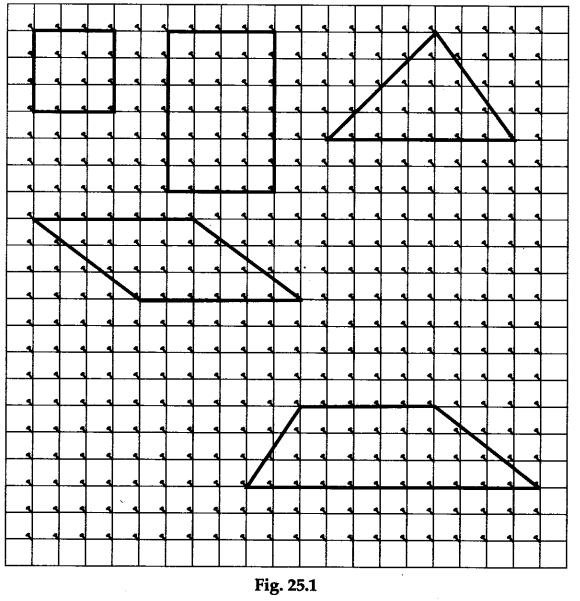Math Labs with Activity – Find the Area of Geometric Figures by Using a Geoboard
OBJECTIVE
To find the area of various geometric figures by using a geoboard.
Materials Required
- A playboard
- A sheet of coloured glazed paper
- A geometry box
- Nails
- A hammer
- A few rubber bands
- A tube of glue
Procedure
Making a Geoboard Paste the coloured glazed paper on the plyboard.
Mark an array of 20 x 20 dots at equal distances of 1 cm each. Fix nails at each one of the dots. We thus get a geoboard.
Using the Geoboard
Step 1: Make different types of geometric figures using rubber bands as shown in Figure 23.1.

Step 2: For each geometric figure count the number of unit squares involved. The area of each complete square is counted as 1 cm² and that of each incomplete square is taken to be ½ cm².
Step 3: The area of each geometric figure is thus calculated and verified by using the formula derived by geometry.
Observations and Calculations
- Area of the Square
Number of complete unit squares = 9.
Number of incomplete unit squares = 0.
∴ area of the given square ={(9 x 1)+(0 x ½)}= 9 cm².
Verification: Each side of the square = 3 cm. (From Figure 25.1.) area (by formula) = 3² =9 cm². - Area of the Rectangle
Number of complete unit squares = 24.
Number of incomplete unit squares = 0.
area of the given rectangle = {(24 x 1)+(0 x ½)}= 24 cm².
Verification: Length = 6 cm and breadth = 4 cm. (From Figure 25.1.) ,
∴ area of the rectangle (by formula) = l x b = 6 x 4 = 24 cm². - Area of the Triangle
Number of complete unit squares = 9.
Number of incomplete unit squares = 10.
∴ area of the given triangle = {(9 x 1)+(10 x ½)} = (9+5) = 14 cm².
Verification: Base = 7 cm and height = 4 cm. (From Figure 25.1.)
∴ area of the triangle (by formula) =½ x b x h = ½ x 7 x 4 = 14 cm². - Area of the Parallelogram
Number of complete unit squares = 12.
∴ area of the given parallelogram = {(12 x 1)+(12 x ½)} = (12+6) = 18 cm².
Number of incomplete unit squares = 12.
Verification: Base = 6 cm and height = 3 cm. (From Figure 25.1.)
∴ area of the given parallelogram (by formula)
=b x h = 6 x 3= 18 cm². - Area of the Trapezium
Number of complete unit squares = 19.
Number of incomplete unit squares = 10.
∴ area of the given trapezium = {(19 x 1)+(10 x ½)} = (19 + 5) = 24 cm².
Verification: The parallel sides of the trapezium are 5 cm and 11 cm and its height is 3 cm. (From Figure 25.1.)
∴ area of the given trapezium (by formula)
= ½ x (sum of the parallel sides) x height
= ½ x (5 +11) x 3 = ½ x 16 x 3 = 24 cm².
Result
The area of any geometric figure estimated by using a geoboard has been verified by using the respective geometric formula.
Math Labs with ActivityMath LabsMath Lab ManualScience LabsScience Practical Skills